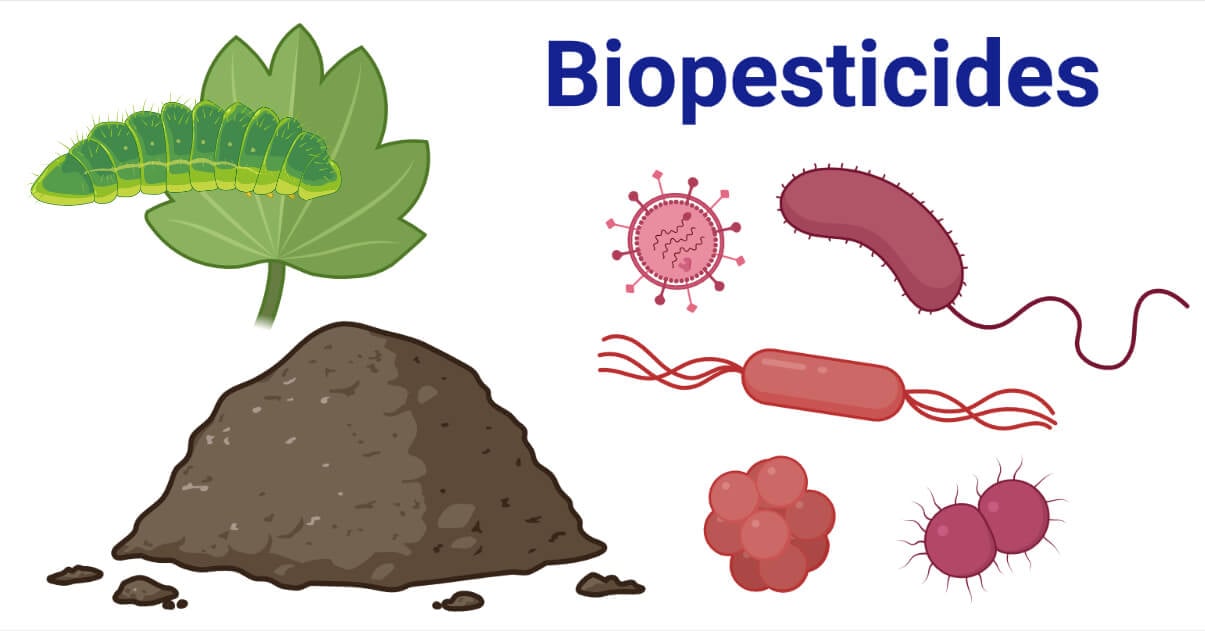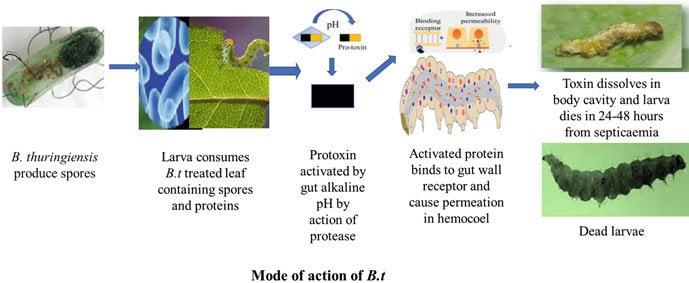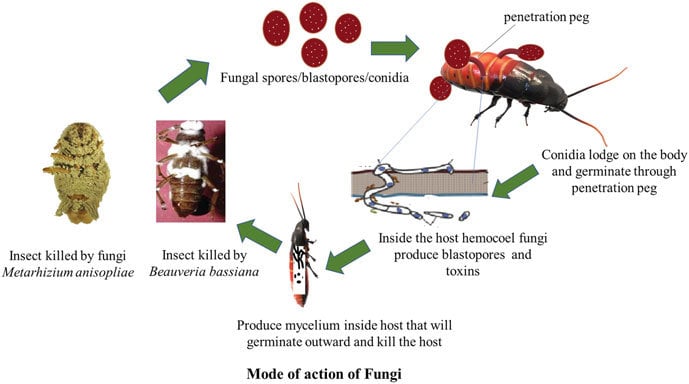Chemical pesticides have been used for a very long time in order to manage plant pests in agriculture. However, using such chemical products is associated with several concerns regarding the impact on human health and the environment. Biopesticides are considered safer pest control alternatives to such chemical products.
Interesting Science Videos
What are Biopesticides?
Biopesticides, also known as biological pesticides, are chemicals made from natural organisms or substances used to control or suppress agricultural pests, weeds, and disease-causing agents by specific biological effects. There are several definitions as to what should be regarded as a biopesticide.

According to the US Environment Protection Agency (EPA), “Biopesticides are certain types of pesticides derived from natural materials such as animals, plants, bacteria, and certain minerals.”
Types of Biopesticides
Based on the source/origin of extraction, biopesticides can be classified into the following three classes:
A. Microbial Pesticides
Microbial pesticides are biopesticides derived from microorganisms, including bacteria, viruses, fungi, protozoa, and entomopathogenic nematodes, which act against specific plant pests.
They control pests by causing disease, creating competition for food and space, producing toxic metabolites, or various other modes of action.
Some important microbial pesticides are briefly described below:
Bacterial biopesticides
- The most common type of microbial pesticides are bacterial biopesticides, mostly used to control insects, but some are also used against other pathogenic bacteria and fungi.
- Among the many species of bacteria with pesticide activity, the entomopathogenic bacterium Bacillus thuringiensis (Bt) Berliner is the most extensively studied and commercially used biopesticide.
- Other commonly used bacterial biopesticides include Bacillus subtilis, Pseudomonas fluorescens, Agrobacterium radiobacter, etc.

Viral biopesticides
- Several virus families are known to infect insects; however, viruses belonging to the family Baculoviridae are the only ones that are used as pesticides in practice.
- Baculoviruses are a group of double-stranded DNA viruses that infect insects. They infect insects through ingestion. Once ingested, they enter the insect’s body and release the baculovirus particles which leads to infection of the gut cells. Within a few days of ingestion, the insect will stop feeding and eventually die releasing the virus particles into the environment.

Fungal biopesticides
- Fungal biopesticides are commonly used to control insects. Some fungi also work against other fungi, bacteria, and other plant pathogens.
- Fungal biopesticides do not have to be ingested to cause infection, unlike bacterial and viral biopesticides. They can penetrate through the insect cuticle and infect pests by either creating competition for space and nutrients or producing toxic secondary metabolites.
- Some of the commonly used fungal biopesticides include Beauveria bassiana, Metarhizium anisopliae, Trichoderma viride, Paecilomyces farinosus, and Verticillium lecanii.

B. Biochemical pesticides
Biochemical pesticides are biopesticides derived from natural substances that control pests by non-toxic methods. They can be further classified into plant extracts, semiochemicals, and growth regulators.
Plant extracts (Botanicals)
- Botanical biopesticides are also an important group of biopesticides that are derived from plant-based extracts and essential oils.
- They include several types of secondary metabolites like steroids, alkaloids, phenolics, terpenoids, and nitrogenated compounds that exhibit pesticidal activity.
- These compounds may work as repellents, growth regulators, and antifeedants. They can also function by inhibiting respiration and causing metabolic dysfunction.
- Some commonly used plant-based biopesticides include Neem (from Azadirachta indica), Nicotine (from Nicotiana species), Pyrethrum (from Dalmatia pyrethrum), Ryanodine (Rayania; from Ryania speciosa), etc.
Semiochemicals
- These are chemicals released by plants or animals that cause behavioral or physiological changes in the receptor organisms of the same or different species.
- They can control plant pests through a wide range of activities like mass trapping, lure and kill, mating disruption, push-pull systems and activating plant defenses.
- Semiochemicals can be classified into two types: Pheromones and Allelochemicals
- Pheromones, also called intraspecific semiochemicals, are chemicals that change the behavior of organisms within the same species.
- Allelochemicals change the behavior of individuals of different species and are also known as interspecific semiochemicals.
Growth regulators
- Insect growth regulators (IGRs) are insecticides that interfere with the growth and development of insects. They work against different insects like mosquitoes, fleas, and cockroaches.
- They include juvenile hormone analogues (JHAs), ecdysteroids analogues, and chitin synthesis inhibitors (CSIs).
- JHAs mimic the juvenile hormones in insects that inhibit the genes promoting maturation into the adult stage.
- CSIs inhibit the formation of chitin which is a major component of the outermost part of insects.
- Ecdysteroids are involved in the molting and metamorphosis process in insects. As a biopesticide, they can interfere with the ability of insects to molt and grow.
C. Plant Incorporated Protectants (PIPS)
- PIPs are a class of biochemical pesticides derived from genetically modified plants. They are produced by transgenic plants incorporated with genetic material that shows pesticide activity.
- The most widely used examples of this method are Bt crops, where Cry proteins from the soil bacterium Bacillus thuringiensis are introduced into the plants.
- Some countries may not consider PIPs as biopesticides because of consumer resistance to genetically modified products.
- Recently, the RNA interference (RNAi) mechanism has also been used to produce a new generation of pesticides. Here, double-stranded RNA is ingested by the pests, which degrades the mRNA of the pests and thus slows their growth or kills them.
Advantages of Biopesticides
Some of the benefits of using biopesticides over traditional chemical pesticides are:
- Biopesticides are environment-friendly and are less toxic to humans and other organisms.
- They are target specific, so they are less likely to harm beneficial organisms.
- There is less risk of developing pest resistance.
- The biodegradable nature of biopesticides reduces the risk of exposure to the environment.
- They are compatible with Integrated Pest Management (IPM) programs
Disadvantages of Biopesticides
Despite all the merits of using biopesticides, they have still been unable to replace conventional chemical pesticides. Some limitations and disadvantages of biopesticides are:
- They have a short shelf life.
- Some biopesticides show limited effectiveness under certain environmental conditions.
- They are only effective against target species, so they control a limited range of pests.
- They may be difficult to apply and confusing to farmers.
- It may take a long time for approval by regulatory bodies, and the cost of production is high.
References
- EPA. Biopesticides. Available online: www.epa.gov/pesticides/biopesticides (accessed on 9 September 2017).
- Kumar, J., Ramlal, A., Mallick, D., & Mishra, V. (2021). An Overview of Some Biopesticides and Their Importance in Plant Protection for Commercial Acceptance. Plants, 10(6). https://doi.org/10.3390/plants10061185
- Liu, X., Cao, A., Yan, D., Ouyang, C., Wang, Q., & Li, Y. (2019). Overview of mechanisms and uses of biopesticides. International Journal of Pest Management, 67(1), 65–72. doi:10.1080/09670874.2019.1664789
- Mehrotra, S., Kumar, S., Zahid, M., & Garg, M. (2016). Biopesticides. Principles and Applications of Environmental Biotechnology for a Sustainable Future, 273–292. doi:10.1007/978-981-10-1866-4_8
- Parker, K. M., Barragán Borrero, V., van Leeuwen, D. M., Lever, M. A., Mateescu, B., & Sander, M. (2019). Environmental fate of RNA interference pesticides: Adsorption and degradation of double-stranded RNA molecules in agricultural soils. Environmental Science & Technology. doi:10.1021/acs.est.8b05576
- Rajamani, M., Negi, A. (2021). Biopesticides for Pest Management. In: Venkatramanan, V., Shah, S., Prasad, R. (eds) Sustainable Bioeconomy. Springer, Singapore. https://doi.org/10.1007/978-981-15-7321-7_11
- Senthil-Nathan, S. (2014). A Review of Biopesticides and Their Mode of Action Against Insect Pests. Environmental Sustainability, 49–63. doi:10.1007/978-81-322-2056-5_3
- Smart, L. E., Aradottir, G. I., & Bruce, T. J. A. (2014). Role of Semiochemicals in Integrated Pest Management. Integrated Pest Management, 93–109. doi:10.1016/b978-0-12-398529-3.00007-5
- Subramanian, S., & Shankarganesh, K. (2016). Insect Hormones (as Pesticides). Ecofriendly Pest Management for Food Security, 613–650. doi:10.1016/b978-0-12-803265-7.00020-8

I would to receive your article. I think it is very interesting and important for the sustainable development of the world.
Best regards
Dr Ziouche S.
sihem.ziouche@univ-bba.dz
I would to receive your article. I think it is very interesting and important for the sustainable development of the world.
Sincerely yours
Dr. Julio Cesar Bracho Pérez
jbracho@untels.edu.pe